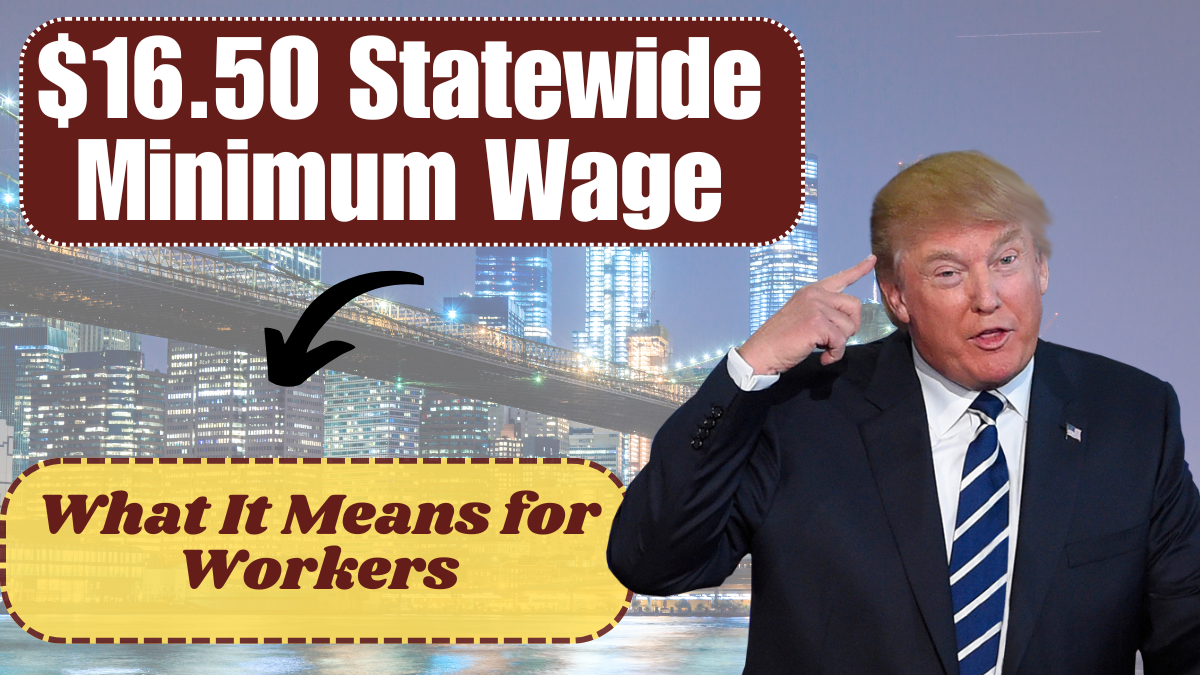In a major move to uplift its working-class population, California has officially raised its minimum wage to $16.50 per hour starting in January 2025. This decision comes as part of the state’s broader strategy to combat the rising cost of living, close income gaps, and ensure that workers across industries can better afford basic needs like housing, healthcare, and food.
The increase is not only symbolic—it is a policy shift that affects millions of Californians, from young hourly workers to parents supporting families on low wages. The wage hike is also expected to influence other states considering similar action.

What the $16.50 Statewide Minimum Wage Means
The new statewide minimum wage of $16.50 per hour applies to all non-exempt employees working in California, regardless of the size of their employer. This is a $0.50 increase from the 2024 minimum wage of $16.00 per hour. The increase reflects inflationary pressures and follows the state’s annual assessment process to ensure wages keep pace with the cost of living.
Workers in industries such as hospitality, food service, retail, cleaning, security, and caregiving will feel the biggest impact. Many of these sectors have long relied on minimum wage labor, and the increase helps bring much-needed income stability to these workers.
Cities and Counties Raising the Bar Even Higher
What sets California apart is not just its high statewide minimum wage, but the fact that many cities and counties enforce local wage laws that go above the state baseline. These local governments are responding to regional differences in living costs, especially in areas where housing and utilities are disproportionately expensive.
Here are some of the highest minimum wages in California cities as of 2025:
- San Francisco: $18.67 per hour – One of the highest in the nation, reflecting the city’s high living expenses.
- Berkeley: Also at $18.67 per hour – Equal to San Francisco and adjusted annually for inflation.
- West Hollywood: Workers now earn a minimum of $19.65 per hour – a bold move by one of the most progressive cities in LA County.
- Cupertino & Santa Clara: Located in the heart of Silicon Valley, both cities have adopted a minimum wage of $18.20 per hour to match the tech-driven local economy.
- Mountain View & Sunnyvale: Also in the Silicon Valley corridor, these cities maintain minimum wages of around $18.50 per hour, adjusted for the Consumer Price Index (CPI).
This trend of local wage leadership underscores how California municipalities are independently pushing for fairer wages—even beyond state mandates.
MUST READ: USA Minimum Wage Increase 2025: Check New Hourly Rates, Tipped Wages & Eligibility
The Ripple Effect on Real Lives
This wage boost isn’t just about a number on a paycheck—it represents financial relief, empowerment, and dignity for millions. Workers on minimum wage often juggle multiple jobs, face housing insecurity, and struggle to keep up with basic expenses. A higher hourly rate means:
- More money in workers’ pockets to spend on food, transportation, healthcare, and childcare
- Less dependence on government aid or food assistance programs
- Better mental health and reduced financial stress
- Improved retention and productivity for businesses
From fast food employees and janitorial staff to grocery clerks and elderly caregivers, this increase helps a broad segment of the workforce make meaningful improvements to their daily lives.
Enforcement and Legal Backing
The California Department of Industrial Relations (DIR) has emphasized that this wage increase is not optional. All employers must comply, regardless of industry or internal agreements. Even collective bargaining contracts cannot legally negotiate below the new minimum standard.
Employers who fail to pay the appropriate minimum wage may face significant penalties, backpay obligations, and legal action. Workers are encouraged to file complaints if they are not being paid according to the law.
Preparing for the Future: What Comes Next
With this new wage in effect, 2025 sets the stage for continued discussions about income equality, fair pay, and sustainable labor policies. As inflation persists and living costs remain high in many urban centers, local governments may soon revisit and revise their wage floors again.
Meanwhile, small businesses, particularly those operating on thin margins, are adapting by reassessing pricing, improving efficiency, and investing in workforce training to boost productivity.
Will the Nation Follow California’s Lead?
California has long been seen as a trendsetter in labor law, environmental policy, and worker protections. Its ambitious wage policy in 2025 may inspire other states to reconsider their stagnant wage floors—especially those still clinging to the federal minimum wage of $7.25 per hour, which hasn’t changed since 2009.
States like Washington, New York, and Massachusetts have already begun moving in this direction, but California’s aggressive stance could create nationwide momentum for change.
Whether you’re a worker trying to understand your rights, an employer planning payroll adjustments, or a policymaker looking for inspiration, one thing is clear: California’s minimum wage increase in 2025 is more than a policy—it’s a movement toward economic justice.
Click here to know more.
Aanchal is a passionate writer with a keen interest in storytelling, content creation, and creative expression. She enjoys exploring diverse topics and crafting engaging narratives that captivate readers.

